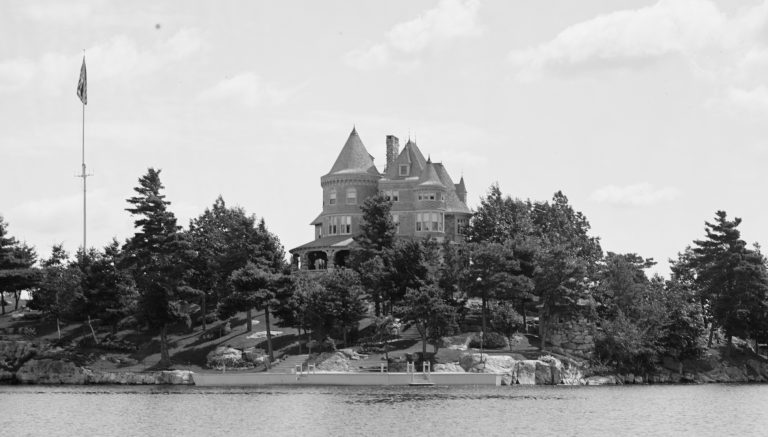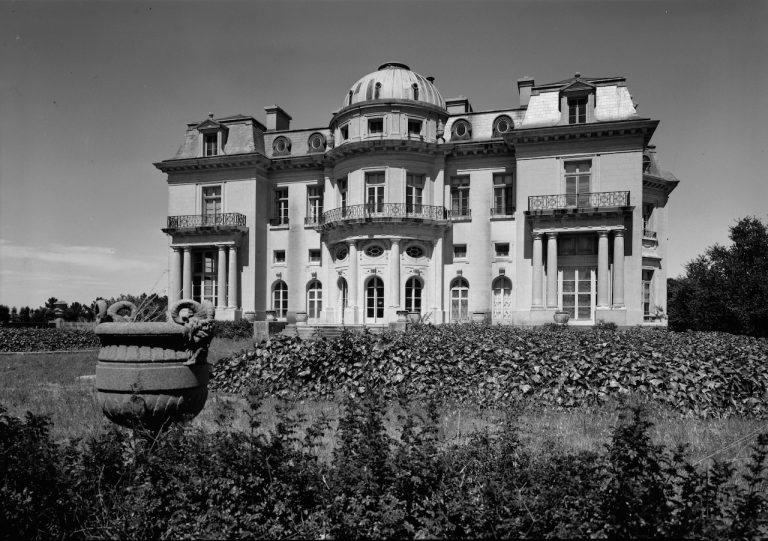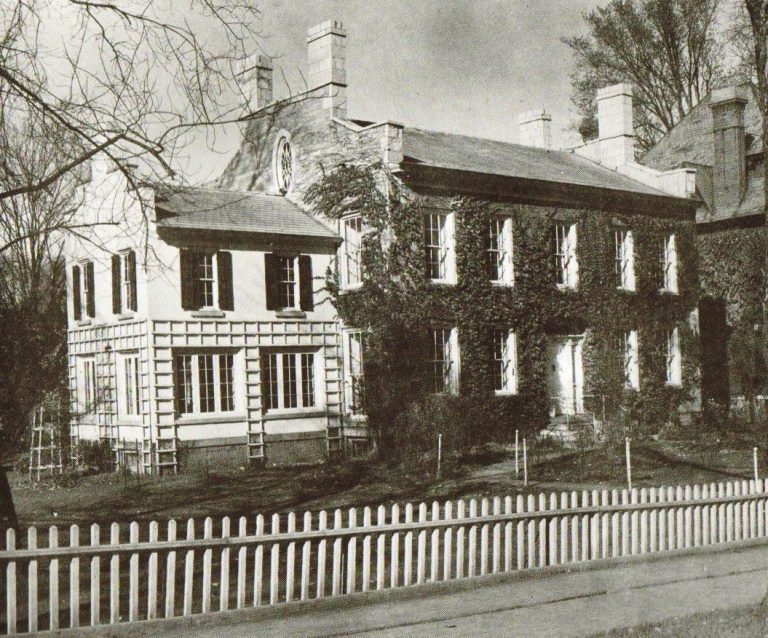Keewaydin, “Northwest Wind,” Constructed In 1893 For J. W. Jackson
Built in 1893 on the mainland shore opposite Comfort Island just southwest of Alexandria Bay, Keewaydin was the summer home for James Wesley Jackson, or J. W. Jackson, of Plainfield, New Jersey (though also referenced as being from New York City.) Its architecture of the Renaissance style with several turrets, it was often comparable to, but not as large as, W. C. Browning’s Hopewell Hall. Nevertheless, it was said to have just as much of a commanding appearance from the river.

Keewaydin, which means “Northwest Wind,” was spelled at least five different ways in its early years when mentioned in the local newspapers before Keewaydin seemed to win the battle of the consonants and vowels. Other spellings to assist future researchers included Keewahdion, Keewadin, Keewayden, and Keewatin, not to mention various hyphenations.
There is surprisingly little information about J. W. Jackson in the newspaper archives, most mentioning of his coming and going, though he was involved in the community and an avid yachtsman, an officer of Thousands Islands Yacht Club, and had one of the first steamboats, “Annabelle,” on the river. There is no mention of his death other than on August 21, 1920, in Watertown Daily Times, when his daughter, Carrie (Caroline) L. Wharton, who had inherited the property, sold it to William T. Dewart of New York. Dewart was born in Fenelon Falls, Canada, and was presumably familiar with the Thousand Islands.
Dewart, who was the publisher of the New York Sun and also owned the Mohican Grocery Store chain and the Munsey Publishing Co., would have distinguished guests at Keewaydin, which included the likes of Munsey Co. editor Robert Hobart Davis, who, according to the Watertown Daily Times, was amongst the first to recognize the genius of O. Henry who he helped early in his burgeoning career. Irvin Shrewsbury Cobb, a famous short story writer, novelist, and humorist, would often accompany his friend Davis to Keewaydin as guests of the Dewarts.

In January 1944, Dewart passed away. Two of his sons, William T. Dewart, Jr. and Tom, both of whom once worked for the Watertown Daily Times, were officers in the Sun Company but were serving in WWII at the time. William Jr. would die in a plane accident in Reno, NV, just two years later at the age of 36.
Three days after spending the weekend as guests of Mr. & Mrs. Roswell Flower Taylor, Mr. & Mrs. John K. Wallace of St. Louis, Mo., would purchase Keewaydin from Mary Wheeler Dewart in late January of 1947. By July of that year, the relationship between Wallace and Taylor would become apparent as it was announced in the Watertown Daily Times–
FORMER DEWART ESTATE IS CLUB
“Keewaydin,” the former beautiful Thousand Islands summer estate of the late William T. Dewart, former of the New York Sun and controlling factor in the Mohican company, is to be conducted as a social club and vacation camp under the control of Whitefish Cove, Inc.
This is a membership corporation just created under New York State’s membership corporation law by John K. Wallace of 401 South 7th Street, St. Louis, Mo., as the head. He and his wife, Mrs. Margaret How Wallace of the same address, Attorneys Roswell F. Taylor, John B. Harris and Stephen A. McKay, city, are the incorporators and the directors are Mr. and Mrs. Wallace and Mr. Taylor.
The name, “Keywaydin,” is an Indian one meaning The Home of the Winds, and the broad porch of the house has a commanding view of the river. It is equipped with boat houses, docks, garages, tennis courts and all necessary adjuncts. Baths are provided with its many rooms and except for horses, it will be operated on the plan of a dude ranch.

Wallace, who already owned the nearby property “Linden Cove,” would later that year purchase “Century House,” which would link the two properties together with Keewaydin. The Keewaydin Point Club, as the venture would become known, would have a modern restaurant and a new dining room annex overlooking the St. Lawrence River. It would operate as the Point Club until 1959, when it was sold once again per the Watertown Daily Times on January 2–
Keewaydin Point Club at Bay Sold
Keewaydin Point Club, consisting of 160 acres of landscaped mainland property with one mile of river frontage, a three story summer residence, caretaker’s cottage, and two boathouses has been by the Tanab Corporation of Watertown, it was announced here today.The property was purchased from John K. Wallace, St. Louis, Mo.
According to plans outlined by Mr. Taitt, the corporation will take possession of the property immediately and begin repairs and construction to develop the two boat house properties into a marina to be known as “Keewaydin Marina” catering to summer storage and dockage for boat owners in the area.
The venture would be a short one. In 1960, voters of New York State passed what would become a $75,000,000 park and land acquisition appropriation that would spell the beginning of the end for Keewaydin as it was known. By January 1961, The Thousand Islands State Park Commission, then headquartered at the Memorial Services Building, the original hospital building of the House of the Good Samaritan in Watertown, would be negotiating the purchase of the 160-acre property, including the mansion.

As Keewaydin State Park was developed in 1965, the commission would consider refurbishing the old mansion for use as its headquarters, but in July of that year, instead, announced its intentions to build a modern facility budgeted at $190,000. Interestingly, and conspicuously absent, was any mention of the building being razed by the Watertown Daily Times other than a September 15, 1965 article where a descendent of J. W. Jackson had returned to the mansion for the first time in 50 years.
Mrs. F. Rufus Searles, great-granddaughter of James Wesley Jackson, had the opportunity to go over the grounds on the way back to Lake George, where she had a summer home with her husband. Her great-grandfather, an investment broker and financial advisor, was a close friend of the Pullman family and others with large estates in the area who probably convinced him to build one of his own. As the Daily Times reported–
The Thousand Islands State Park commission is planning to make extensive repairs and alterations to the property, using it for headquarters.
“I do not know whether they plan to raze the palatial summer home, but I certainly wish that I could get some memento from the commission,” said. Mrs. Searles. “As I went over the grounds this week there was really much nostalgia attached to the property. I couldn’t help feeling attachment to it as I walked over the grounds, looked at the buildings and thought of the happy times I had visiting Keewaydin.”
And that was all the mentioning of the Keewaydin summer home there was. Even amongst the contracts awarded, construction updates of the new commission’s office, etc., there was no mention of demolishing the building. Hopefully, Mrs. Searles could get a memento or two to go with her trip down memory lane.
Today, the location of the former Keewaydin mansion and its property is part of the 282-acre Keewaydin State Park, which is open year-round.
The following video, from WPBS, shows some of the notable places of the Thousand Islands. The video has been cued to start at the short segment on Keewaydin and its history.












2 Reviews on “Keewaydin – 1000 Islands (1893 – 1966)”
In this article you reference a Mr. Taitt. I believe this to be Murray Taitt, who was my uncle. Is this correct and if so, is there more information surrounding him regarding Keewaydin ? My email is quixotedoc@yahoo.com….Thank you…..Dr. Lance Percy
Yes, Murray A. Taitt. I’ll take a look and see if anything else comes up with his name associated with Keewaydin and will forward a copies of any articles to you.
I wish they had never taken that beautiful home down. I spent many summers there camping from 69′ until 83′ then started taking my mother there to fish until she was 85. I remember the old ice house by the river and the complete gazebo by the water before people started to destroy the work. I am grateful there have been strides made to preserve what is left. I vaguely remember the old house or parts of it left at the north end of the property towards the bay. Now there is just the beautiful staircase. I wish there were more photos of the houses on the properties when combined.